Samsung Agrees to Compensation Deal Over Chip Worker Deaths, Illnesses

SEOUL—After a decadelong standoff over factory workers who died or became ill due to chemical exposure, Samsung Electronics Co. on Tuesday moved to end the dispute, vowing to accept a yet-to-be-determined settlement from an independent mediator.
Under the deal, which was also signed by a group representing the workers, a mediation panel will decide how to compensate the victims and their families and will establish measures to prevent recurrences of such work-related illnesses at Samsung.
Both parties agreed in advance to accept the final decision of the mediator, which is expected to present its findings by October at the latest.
Placing the outcome in the hands of the independent committee, which was created in 2014 following talks between Samsung and groups representing the families of victims, is a change in strategy for the company. For years, Samsung had resisted efforts to settle the claims.
It isn’t clear how many workers will be covered by the settlement agreement, nor how they or their families will be compensated. But, over the years, dozens of workers at Samsung’s semiconductor and display production plants have blamed the company’s handling of chemicals for cases of leukemia and other diseases, sometimes leading to death.
The first case to come to light was that of Hwang Yu-mi, who died of leukemia in 2007—aged 21—after she worked on a Samsung chip-production line. During her 20 months working there, she manually doused chemicals on wafers—a material used to produce chips—with limited protective gear.
Ms. Hwang’s story inspired other workers to come forward, and in 2014, the Seoul High Court recognized her death as an occupational hazard.
‘It’s regretful that we haven’t been able to resolve cases of workers who have fallen ill and died from hazardous chemicals for over 10 years, a long time, because they are poor and weak.’
Supporters for the Health and Rights of People in the Semiconductor Industry (SHARPS), an advocacy group for victims, say that since the 1990s at least 80 people who worked at Samsung plants have died from diseases including breast cancer, multiple sclerosis and malignant lymphoma.
SHARPS said 23 of 70 cases have been recognized by the South Korean government or courts as occupational hazards, adding that some victims’ cases couldn’t be brought for review as a three-year limit on making claims had passed.
Samsung, which declined to comment on the number of victims, said Tuesday that it would be “meaningful” to be to reach “a complete solution” on the issue.
SHARPS also welcomed the agreement, but was critical of how long it took to break the deadlock.
“It’s regretful that we haven’t been able to resolve cases of workers who have fallen ill and died from hazardous chemicals for over 10 years, a long time, because they are poor and weak,” said Hwang Sang-gi, the father of the late Ms. Hwang, at Tuesday’s signing ceremony. “This should never be repeated,” he said.
Since Ms. Hwang’s death, Samsung has emerged as the world’s largest memory chip manufacturer. Sales of chips accounted for 74% of the company’s operating profit in its most recent fourth consecutive quarter of record operating profit.
In 2015, after previous efforts to settle with workers failed, Samsung started its own program to compensate some victims through a 100 billion won ($88 million) fund—a move criticized at the time by SHARPS because it fell short of a formal apology and lacked comprehensiveness.
The fund provided financial aid and additional safety measures for some 130 employees and on-site contractors, a company spokeswoman said Tuesday. She declined to comment on the total amount of compensation paid, but added that former Samsung chief executive officer Kwon Oh-hyun had in 2014 formally apologized over the illnesses and deaths.
Write to Eun-Young Jeong at Eun-Young.Jeong@wsj.com
